cooling BUICK CENTURY 1993 Owners Manual
[x] Cancel search | Manufacturer: BUICK, Model Year: 1993, Model line: CENTURY, Model: BUICK CENTURY 1993Pages: 324, PDF Size: 17.58 MB
Page 73 of 324
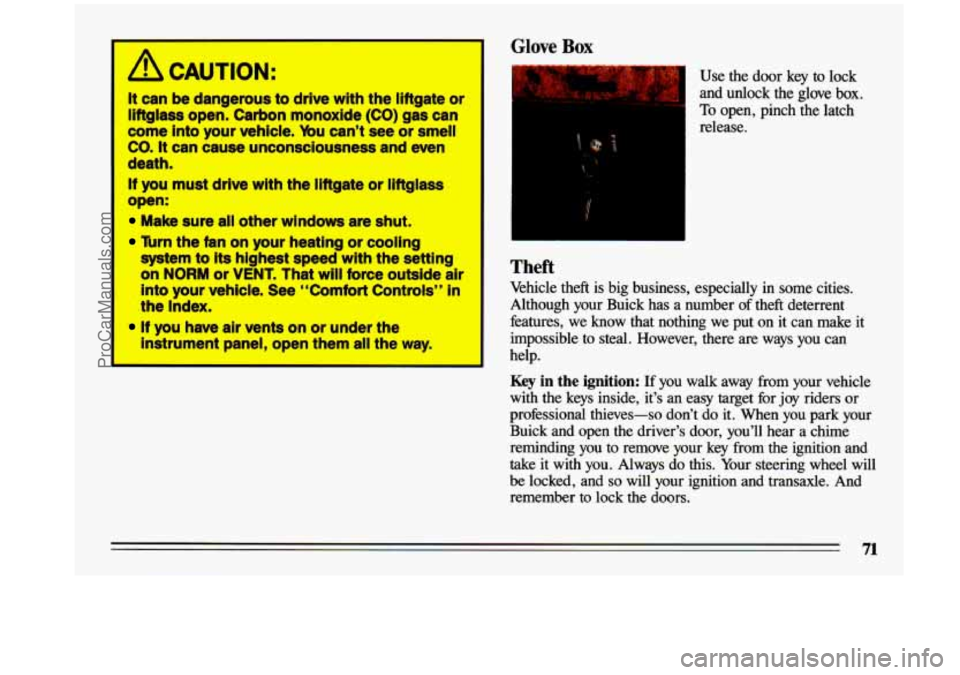
/r CAUTION:
It can be dangerous to drive with the liftgate or
liftglass open. Carbon monoxide (CO) gas can
come
into your vehicle. You can’t see or smell
CO.
It can cause unconsciousness and even
death.
If you must drive with the liftgate or liftglass
open:
Make sure all other windows are shut.
Turn the fan on your heating or cooling
system
to its highest speed with the setting
on NORM
or VENT. That will force outside air
into your vehicle. See “Comfort Controls’’ in
.the Index.
instrument panel, ope1 hem all the way.
If you have air vents on or under the
Glove Box
Use the door key to lock
and unlock the glove box.
To open, pinch the latch
release.
Theft
Vehicle theft is big business, especially in some cities.
Although
your Buick has a number of theft deterrent
features, we know that nothing we put on it can make it
impossible to steal. However, there are ways you can
help.
Key in the ignition: If you walk away from your vehicle
with the keys inside, it’s an easy target for
joy riders or
professional thieves-so don’t do it. When you park your
Buick and open the driver’s door, you’ll hear
a chime
reminding
you to remove your key from the ignition and
take it with you. Always do this. Your steering wheel will
be locked, and
so will your ignition and transaxle. And
remember to lock the doors.
n
ProCarManuals.com
Page 112 of 324
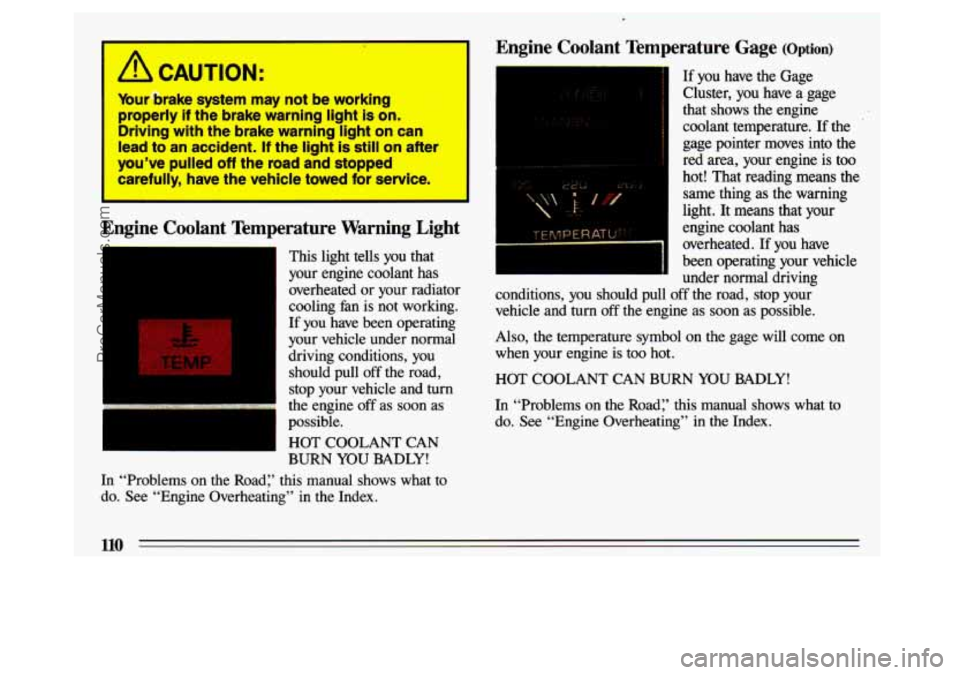
A CAUTION:
Your brake system may not be working properly
if the brake warning light is on.
Driving with the brake warning light on can
lead to an accident.
If the light is still on after
you’ve pulled
off the road and stopped
carefully, have the vehicle towed
for service.
Engine Coolant Temperature Warning Light
---I
This light tells you that
your engine coolant has
overheated or your radiator
cooling
fan is not working.
If you have been operating
your vehicle under normal
driving conditions, you should pull
off the road,
stop your vehicle and
turn
the engine off as soon as
possible.
HOT COOLANT CAN
BURN YOU BADLY!
In “Problems on the Road:’ this manual shows what to
do. See “Engine Overheating” in the Index.
Engine Coolant Temperature Gage (Option)
‘1 If you have the Gage
Cluster, you have a gage
that shows the engine
coolant temperature.
If the
gage pointer moves into the red area, your engine is too
hot! That reading means the same thing as the warning
light. It means that your engine coolant has
overheated. If you have
been operating your vehicle under normal driving
conditions, you should pull off the road, stop your-
vehicle and
turn off the engine as soon as possible.
Also, the temperature symbol on the gage will come on
when your engine is too hot.
HOT COOLANT CAN BURN YOU BADLY!
In “Problems on the Road:’ this manual shows what to
do. See “Engine Overheating” in the Index.
110
ProCarManuals.com
Page 116 of 324
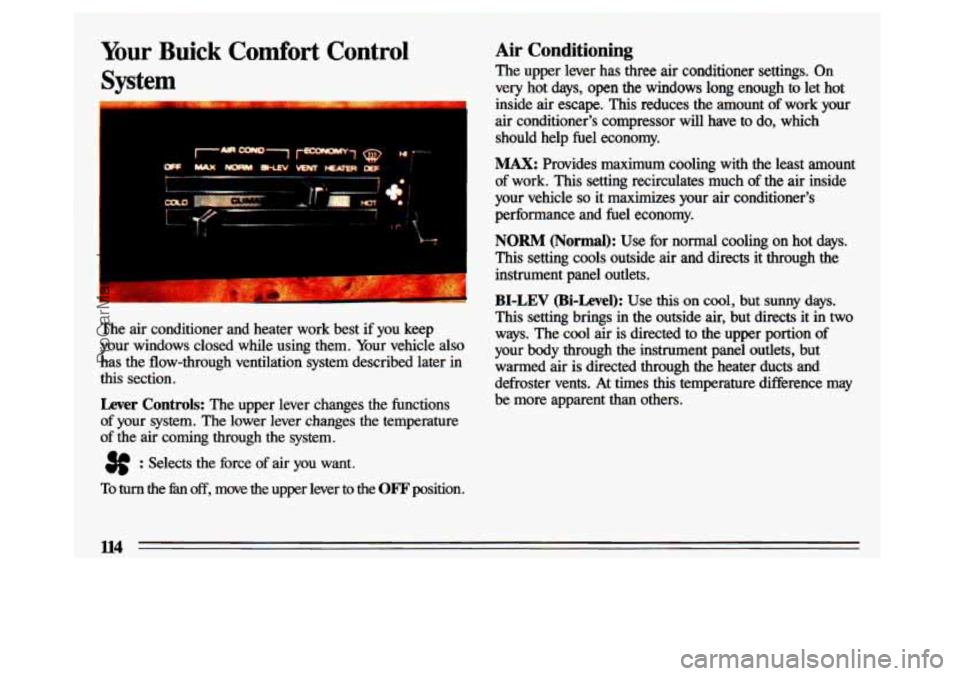
1
Your Buick Comfort Control
Syst m -
The air conditioner and heater work best if you keep
your windows closed while using them. Your vehicle
also
has the flow-through ventilation system described later in
this section.
Lever Controls: The upper lever changes the functions
of your system. The lower lever changes the temperature
of the air coming through the system.
3f : Selects the force of air you want.
Air Conditioning
The upper lever has three air conditioner settings. On
very hot days, open the windows long enough to let hot
inside air escape.
This reduces the amount of work your
air conditioner's compressor
will have to do, which
should help fuel economy.
MAX: Provides maximum cooling with the least amount
of work. This setting recirculates much of the air inside
your vehicle
so it maximizes your air conditioner's
performance and
fuel economy.
NORM (Normal): Use for normal cooling on hot days.
This setting cools outside air and directs it through the
instrument panel outlets.
BI-LEV (Bi-Level): Use this on cool, but sunny days.
This setting brings in the outside air, but directs it in two\
ways. The cool air
is directed to the upper portion of
your body through the instrument panel
outlets, but
warmed air is directed through the heater ducts and
defroster vents. At times
this temperature difference may
be more apparent than others.
To turn the 5x1 off, move the upper lever to the OF'F position.
ll4
ProCarManuals.com
Page 117 of 324
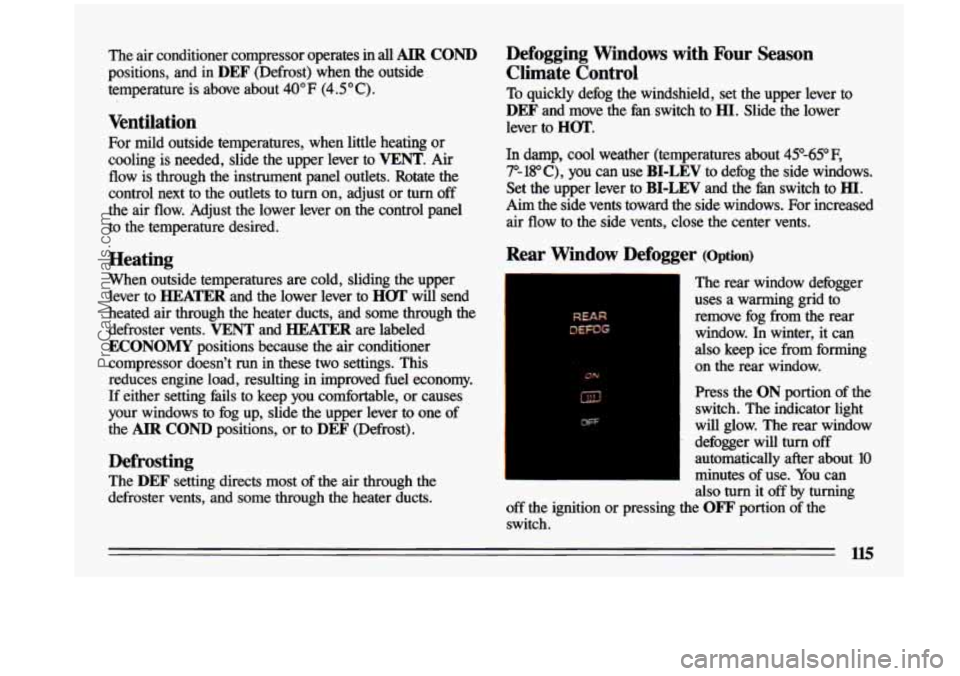
The air conditioner compressor operates in all AIR COND
positions, and in DEF (Defrost) when the outside
temperature is above about 40°F (4.5"
C).
Ventilation
For mild outside temperatures, when little heating or
cooling is needed, slide the upper lever to
VENT. Air
flow is through the instrument panel outlets. Rotate the
control next to the outlets to turn on, adjust or
turn off
the air flow. Adjust the lower lever on the control panel
to the temperature desired.
Heating
When outside temperatures are cold, sliding the upper
lever to
HEATER and the lower lever to HOT will send
heated air through the heater ducts, and some through the
defroster vents.
VENT and HEAmR are labeled
ECONOMY positions because the air conditioner
compressor doesn't run
in these two settings. This
reduces engine load, resulting
in improved he1 economy.
If either setting fails to keep you comfortable, or causes
your windows
to fog up, slide the upper lever to one of
the
AIR COND positions, or to DEF (Defrost).
Defrosting
The DEF setting directs most of the air through the
defroster vents, and some through the heater ducts.
Defogging Windows with Four Season
Climate Control
To quickly defog the windshield, set the upper lever to
DEF and move the hn switch to HI. Slide the lower
lever
to HOT.
In damp, cool weather (temperatures about 45"-65"F,
7"- 18" C), you can use BI-LEV to defog the side windows.
Set the upper lever to
BI-LEV and the fan switch to HI.
Aim the side vents toward the side windows. For increased
air flow to the side vents, close the center vents.
Rear Window Defogger (Option)
--
The rear window defogger
uses
a warming grid to
remove fog from the rear
window.
In winter, it can
also keep ice from forming
on the rear window.
Press the
ON portion of the
switch. The indicator light
will glow. The rear window
defogger will
turn off
automatically after about
10
minutes of use. You can
also turn
it off by turning
off the ignition or pressing the
OFF portion of the
switch.
ProCarManuals.com
Page 168 of 324
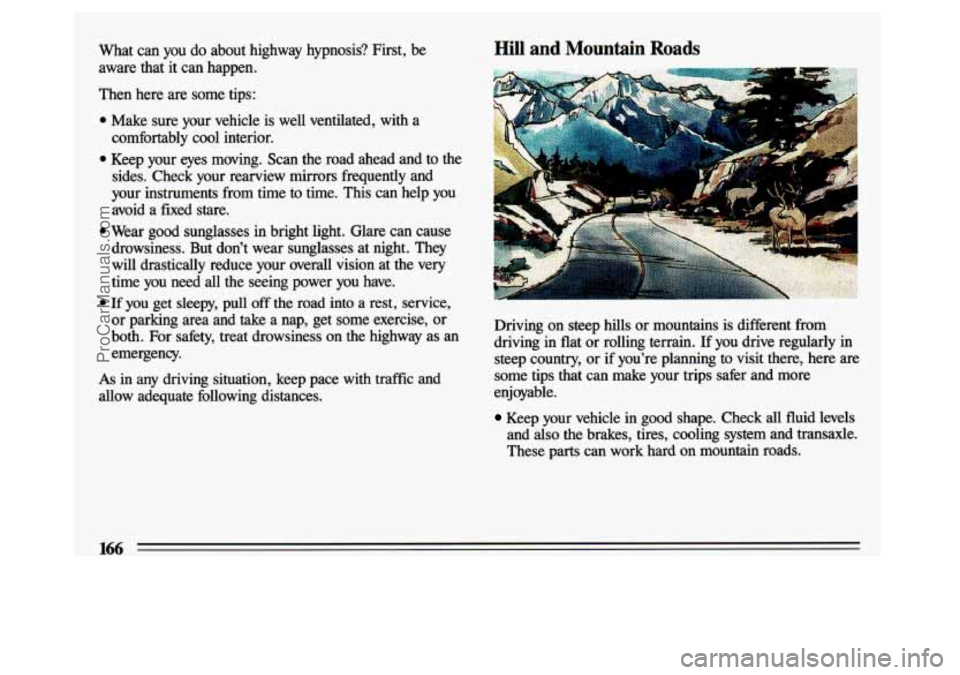
What can you do about highway hypnosis? First, be Hill and Mountain Roads
As in any driving situation, keep pace with traffic and
allow adequate following distances. Driving on steep hills
or mountains is different from
driving in flat or rolling terrain. If you drive regularly in
steep country, or if you’re planning
to visit there, here are
some tips that can make your trips safer and more
enjoyable.
Keep your vehicle in good shape. Check all fluid levels
and also the brakes, tires, cooling system and transaxle.
These parts can work hard on mountain roads.
166
ProCarManuals.com
Page 178 of 324
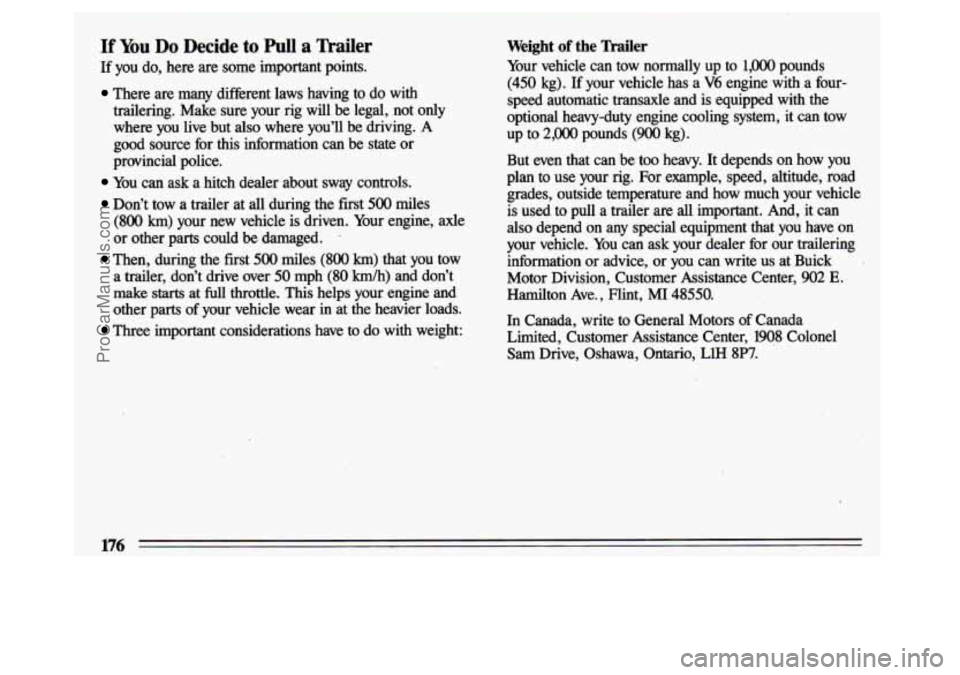
If You Do Decide to Pull a Trailer
If you do, here are some important points.
There are many different laws having to do with
trailering. Make sure your rig will be legal, not only where you live but also where you’ll be driving.
A
good source for this information can be state or
provincial police.
You can ask a hitch dealer about sway controls.
Don’t tow a trailer at all during the first 500 miles
(800 km) your new vehicle is driven. Your engine, axle
or other parts could be damaged. .
Then, during the first 500 miles (800 km) that you tow
a trailer, don’t drive over 50 mph (80 Wh) and don’t
make starts at full throttle. This helps your engine and
other parts of your vehicle wear
in at the heavier loads.
Three important considerations have to do with weight:
Weight of the Trailer
Your vehicle can tow normally up to 1,OOO pounds
(450 kg). If your vehicle has a V6 engine with a four-
speed automatic transaxle and is equipped with the
optional heavy-duty engine cooling system,
it can tow
up to 2,000 pounds
(900 kg).
But even that can be too heavy. It depends on how you
plan to use your rig. For example, speed, altitude, road grades, outside temperature and how much your vehicle
is used to pull
a trailer are all important. And, it can
also depend on any special equipment that you have on
your vehicle. You can ask your dealer for our trailering
information or advice, or you can write us at Buick
.
Motor Division, Customer Assistance Center, 902 E.
Hamilton Ave., Flint, MI 48550.
In Canada, write to General Motors of Canada
Limited, Customer Assistance Center, 1908 Colonel
Sam Drive, Oshawa, Ontario,
LlH 8W.
176
ProCarManuals.com
Page 183 of 324

Maintenance When Trailer Towing
Your vehicle will need service more often when you’re
pulling a trailer. See the Maintenance Schedule for more
on this. Things that are especially important in trailer
operation
are automatic transaxle fluid (don’t overfill),
engine oil, belt, cooling. system, and brake adjustment.
Each of these is covered in this manual, and the Index
‘will help you find them quickly.
If you’re trailering, it’s a
good idea to review these sections before you
start your trip.
Check periodically
to see that all hitch nuts and bolts are
tight.
181
ProCarManuals.com
Page 199 of 324
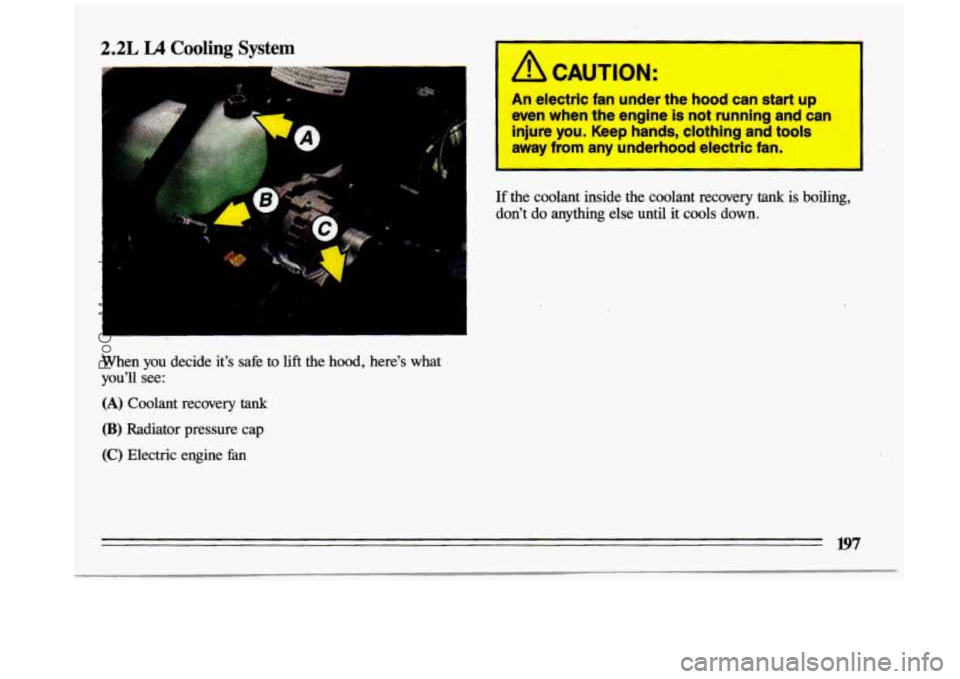
2.2L L4 Cooling System
=
1
When you decide it’s safe to lift the hood, here’s what
you’ll
see:
(A) Coolant recovery tank
(B) Radiator pressure cap
(C) Electric engine fan
It!, CAUTION:
An electric fan under the hood can start up
even when the engine is not running and can
injure you. Keep hands, clothing and tools
away from any underhood electric fan.
If the coolant inside the coolant recovery tank is boiling,
don’t do anything else until it cools down.
ProCarManuals.com
Page 200 of 324
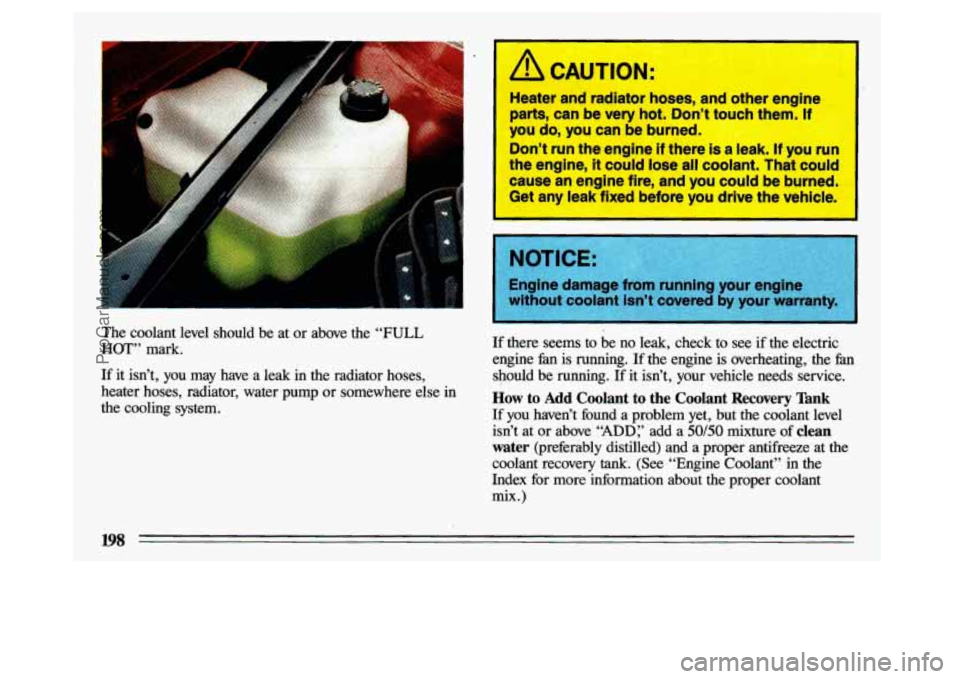
I
The coolant level should be at or above the “FULL
HOT” mark.
If it isn’t, you may have a leak in the radiator hoses,
heater hoses, radiator, water pump or somewhere else in
the cooling system.
1 [ CAUTION:
Heater and radiator hoses, and other engine
parts, can be very
hot. Don’t touch them. If
you
do, you can be burned.
Don’t run the engine if there
is a leak. If you run
the engine,
it could lose all coolant. That could
cause an engine fire, and you could be burned.
Get any leak fixed before you drive the vehicle.
If there seems to be no leak, check to see if the electric
engine
f8n is running. If the engine is overheating, the f8n
should be running. If it isn’t, your vehicle needs service. \
How to Add Coolant to the Coolant Recovery lhnk
If you haven’t found a problem yet, but the coolant level
isn’t at or above
“ADD:’ add a 50/50 mixture of clean
water (preferably distilled) and a proper antifreeze at the
coolant recovery
tank. (See “Engine Coolant” in the
Index for more information about the proper coolant
mix.)
i
I98
ProCarManuals.com
Page 201 of 324
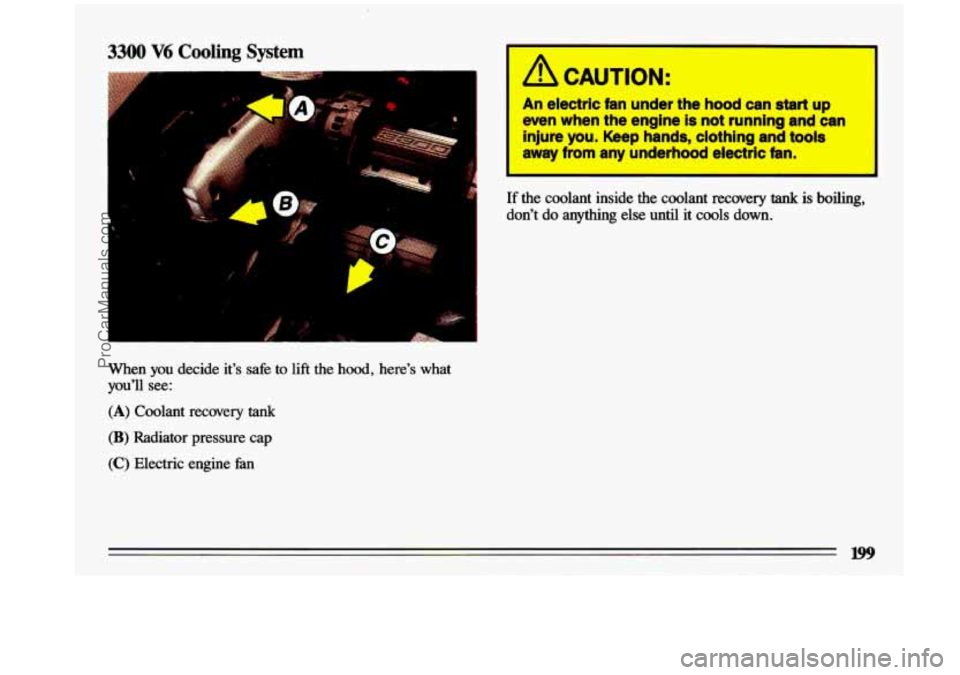
3300 V6 Cooling System
When you decide it’s safe to lift the hood, here’s what
you’ll see:
(A) Coolant recovery tank
(B) Radiator pressure cap
(C) Electric engine fan
I A CAUTION:
An electrlc fan under the hood can start up
even when the englne Is not running and can
injure
YOU. Ksep hands, clothing and twls
away from any underhood electric fan.
If the coolant inside the coolant recovery tank is boiling,
don’t do anything else until it cools down.
ProCarManuals.com